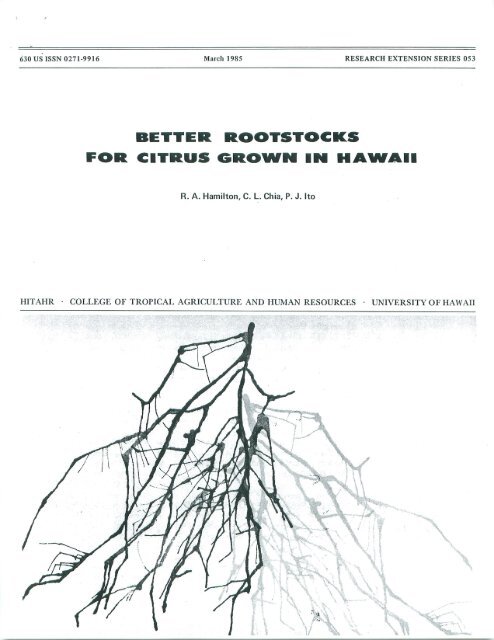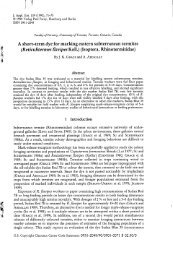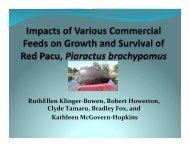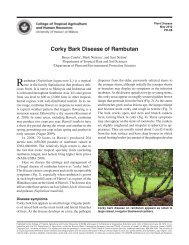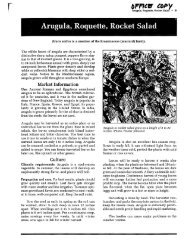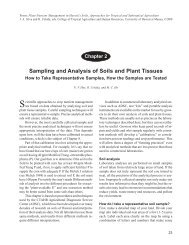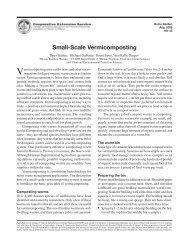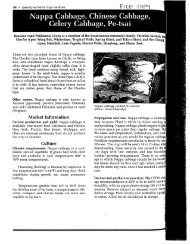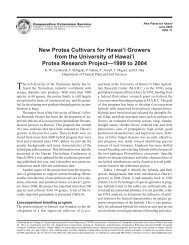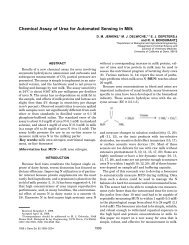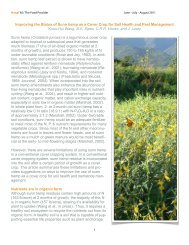Better Rootstalks for Citrus Grown in Hawaii - ctahr - University of ...
Better Rootstalks for Citrus Grown in Hawaii - ctahr - University of ...
Better Rootstalks for Citrus Grown in Hawaii - ctahr - University of ...
You also want an ePaper? Increase the reach of your titles
YUMPU automatically turns print PDFs into web optimized ePapers that Google loves.
630 US ISSN 0271-9916 March 1985 RESEARCH EXTENSION SERIES 053<br />
FOR CITRUS GROWN IN HAWAII<br />
R. A. Hamilton, C. L. Chia, P. J. Ito<br />
HITAHR • COLLEGE OF TROPICAL AGRICULTURE AND HUMAN RESOURCES • UNIVERSITY OF HAWAII<br />
\
Library <strong>of</strong> Congress Catalog<strong>in</strong>g <strong>in</strong> Publication Data<br />
Hamilton, Richard A. (Richard Airth),<br />
<strong>Better</strong> rootstocks <strong>for</strong> citrus grown <strong>in</strong> <strong>Hawaii</strong>.<br />
(Research extension series, ISSN 0271-9916 ;<br />
1. <strong>Citrus</strong> fruits-<strong>Hawaii</strong>-Rootstocks. 2. <strong>Citrus</strong><br />
fruits-Rootstocks. I. Chia, C. L. (Chian Leng),<br />
. II. Ito, P. J. (Philip J.),<br />
III. Title. IV. Series.<br />
SB369.2.H3H35 1984 634'.3541'09969 84-19178<br />
NOTE: This publication is a revision <strong>of</strong> Circular 397, pub<br />
lished by the <strong>Hawaii</strong> Cooperative Extension Service <strong>in</strong> 1962.<br />
THE AUTHORS<br />
R. A. Hamilton is Emeritus Pr<strong>of</strong>essor <strong>of</strong> Horticul<br />
ture, College <strong>of</strong> Tropical Agriculture and Human<br />
Resources, <strong>University</strong> <strong>of</strong> <strong>Hawaii</strong>.<br />
C. L. Chia is Extension Specialist <strong>in</strong> Horticulture,<br />
College <strong>of</strong> Tropical Agriculture and Human<br />
Resources, <strong>University</strong> <strong>of</strong> <strong>Hawaii</strong>.<br />
P. J. Ito is Pr<strong>of</strong>essor <strong>of</strong> Horticulture, College <strong>of</strong><br />
Tropical Agriculture and Human Resources, Uni<br />
versity <strong>of</strong> <strong>Hawaii</strong>.<br />
CONTENTS<br />
Page<br />
Introduction 3<br />
Characteristics <strong>of</strong> Recommended Rootstocks ... 5<br />
Other Rootstocks 7<br />
Tables<br />
1. Rootstocks recommended <strong>for</strong> citrus fruits<br />
<strong>in</strong> <strong>Hawaii</strong> 5<br />
2. <strong>Citrus</strong> rootstocks not recommended <strong>for</strong> use<br />
<strong>in</strong> <strong>Hawaii</strong> 7<br />
:
INTRODUCTION<br />
BETTER ROOTSTOCKS FOR CITRUS GROWN IN HAWAII<br />
<strong>Citrus</strong> fruits have been grown <strong>in</strong> <strong>Hawaii</strong> s<strong>in</strong>ce<br />
1792, when seeds <strong>of</strong> the so-called <strong>Hawaii</strong>an orange<br />
were <strong>in</strong>troduced from Capetown, South Africa, by<br />
Capta<strong>in</strong> George Vancouver. This same type <strong>of</strong><br />
orange has been known on <strong>Hawaii</strong> as the Kona<br />
orange, on Oahu as the Waialua orange, and on<br />
Kauai as the Waimea orange. S<strong>in</strong>ce this orig<strong>in</strong>al <strong>in</strong><br />
troduction, thousands <strong>of</strong> citrus trees <strong>of</strong> several dif<br />
ferent species have been grown <strong>in</strong> home fruit gar<br />
dens. Numerous small, semicommercial plant<strong>in</strong>gs<br />
<strong>of</strong> tanger<strong>in</strong>es, limes, and oranges have been made,<br />
but acreages have rema<strong>in</strong>ed small; at present there<br />
are only about 120 acres <strong>of</strong> commercial orange<br />
plant<strong>in</strong>gs and 25 acres <strong>of</strong> tanger<strong>in</strong>es <strong>in</strong> the State.<br />
In the past, very little attention was paid to<br />
select<strong>in</strong>g the most suitable rootstocks <strong>for</strong> citrus. A<br />
large proportion <strong>of</strong> the citrus trees <strong>in</strong> the State are<br />
either seedl<strong>in</strong>gs or air-layered trees. In <strong>Hawaii</strong>, cit<br />
rus has usually been grown on rootstocks chosen<br />
<strong>for</strong> convenience or by circumstances, rather than<br />
<strong>for</strong> desirable or useful qualities. In recent years<br />
Troyer citrange, Cleopatra mandar<strong>in</strong>, Sw<strong>in</strong>gle citru-<br />
melo, and several other rootstocks have been tried<br />
<strong>in</strong> <strong>Hawaii</strong> although there has been little or no ex<br />
perience or background <strong>in</strong><strong>for</strong>mation on their per<br />
<strong>for</strong>mance.<br />
<strong>Citrus</strong> rootstocks are important because they <strong>in</strong><br />
fluence disease resistance, tree vigor, productivity,<br />
and quality <strong>of</strong> fruit produced. It is only common<br />
sense and good judgment to use the best rootstocks<br />
available <strong>in</strong> new or replacement home plant<strong>in</strong>gs, as<br />
well as <strong>in</strong> commercial orchards. Because <strong>of</strong> the<br />
usual difficulty <strong>in</strong> market<strong>in</strong>g Island-grown citrus<br />
fruit, any means <strong>of</strong> improv<strong>in</strong>g quality and market<br />
ability would be desirable and worthwhile.<br />
The use <strong>of</strong> disease-resistant or tolerant rootstocks<br />
is def<strong>in</strong>itely advisable as a protective measure<br />
aga<strong>in</strong>st gummosis, or gumm<strong>in</strong>g disease, commonly<br />
a serious problem on citrus grown on heavy soils or<br />
under conditions <strong>of</strong> high ra<strong>in</strong>fall and humidity.<br />
Gummosis, also known as foot rot, is caused by<br />
R. A. Hamilton, C. L. Chia, and P. J. Ito<br />
soilborne fungi (Phytophthora spp,), which attack<br />
the tree near ground level (see Figure 1). Because<br />
<strong>of</strong> this, resistant rootstocks should be used when<br />
ever possible, and nursery stock should always be<br />
grafted 12 to 18 <strong>in</strong>ches above ground level to pro<br />
vide maximum protection.<br />
Resistance to "tristeza" virus is also extremely<br />
important because a severe stra<strong>in</strong> <strong>of</strong> this disease is<br />
widespread <strong>in</strong> <strong>Hawaii</strong>. Tristeza stra<strong>in</strong>s have been<br />
<strong>in</strong>troduced repeatedly <strong>in</strong> citrus nursery stock im<br />
ported from the U.S. Ma<strong>in</strong>land and the Orient.<br />
Tristeza, <strong>of</strong>ten referred to as "quick decl<strong>in</strong>e," is<br />
a virus <strong>in</strong>fection that results <strong>in</strong> the block<strong>in</strong>g or <strong>in</strong><br />
terference <strong>of</strong> conduct<strong>in</strong>g tissue at the graft union<br />
<strong>of</strong> susceptible scion/rootstock comb<strong>in</strong>ations. De<br />
cl<strong>in</strong>e, dieback, and a general unhealthy condition<br />
<strong>of</strong> the tree are usual symptoms <strong>of</strong> tristeza. When<br />
a section <strong>of</strong> bark is removed, pitt<strong>in</strong>g or pitted fur<br />
rows usually can be found <strong>in</strong> the wood <strong>of</strong> trees<br />
suffer<strong>in</strong>g from tristeza (see Figure 2). Rootstocks<br />
resistant or tolerant to tristeza are considered the<br />
most effective protection aga<strong>in</strong>st this disease (see<br />
Figure 3).<br />
Accord<strong>in</strong>g to evidence accumulated to date, root<br />
stocks proposed <strong>in</strong> Table 1 appear most satisfac<br />
tory <strong>for</strong> citrus <strong>in</strong> <strong>Hawaii</strong>. A dozen or more other<br />
rootstocks listed <strong>in</strong> Table 2 have been tested <strong>in</strong> ex<br />
perimental plant<strong>in</strong>gs <strong>in</strong> the State, but to date have<br />
not proved promis<strong>in</strong>g enough to be recommended.<br />
Rough lemon and pummelo seedl<strong>in</strong>gs are gener<br />
ally unsatisfactory rootstocks <strong>for</strong> tanger<strong>in</strong>es and<br />
oranges, and the four rootstocks listed <strong>in</strong> Table 1<br />
are suggested as be<strong>in</strong>g more suitable. Orange and<br />
tanger<strong>in</strong>e trees grown on rough lemon roots are<br />
susceptible to gummosis, especially on heavy soils<br />
or <strong>in</strong> high-ra<strong>in</strong>fall areas. In general, they produce<br />
fruit lower <strong>in</strong> sugar content and coarser <strong>in</strong> texture<br />
than those grown on rootstocks recommended <strong>in</strong><br />
Table 1. Pummelo seedl<strong>in</strong>gs are frequently <strong>in</strong>com<br />
patible with other citrus species, and there<strong>for</strong>e do<br />
not make satisfactory rootstocks <strong>for</strong> citrus cul-<br />
tivars.
Figure 1. Advanced stage <strong>of</strong> gummosis on sweet<br />
orange.<br />
Figure 3. A strong, disease-resistant graft union <strong>of</strong><br />
Chun pummelo grafted on Heen Naran<br />
rootstock.<br />
Figure 2. Kusaie lime branches with bark removed. Left, from a disease-free tree.<br />
Right, from a tree affected by tristeza. Note pitted furrows <strong>in</strong> wood.
Up to now, competition from imported oranges<br />
has placed locally grown oranges at a disadvantage<br />
<strong>in</strong> Island markets. This trend can be expected to<br />
cont<strong>in</strong>ue unless the quality and appearance <strong>of</strong><br />
Island-grown oranges are markedly improved. Even<br />
with good rootstocks, improved fertilizer practices,<br />
and a suitable spray program, high quality oranges<br />
rarely can be produced <strong>in</strong> <strong>Hawaii</strong> because <strong>of</strong> clima<br />
tic limitations. As <strong>in</strong> other areas with a mild trop<br />
ical climate, it is seldom possible to produce top<br />
quality, highly colored oranges with a desirable<br />
ratio <strong>of</strong> sweetness to acidity. This is because the<br />
mild, uni<strong>for</strong>m Island climate is generally not con<br />
ducive to the development <strong>of</strong> well colored, high<br />
quality oranges competitive with Cali<strong>for</strong>nia-grown<br />
fruit. However, the use <strong>of</strong> well adapted, disease-<br />
resistant rootstocks to improve the quality <strong>of</strong> cit<br />
rus fruit produced <strong>in</strong> <strong>Hawaii</strong> still deserves consid<br />
eration by nurserymen and home gardeners. Table<br />
1 lists the best rootstocks tested to date <strong>for</strong> citrus<br />
cultivars commonly grown <strong>in</strong> the State. These four<br />
rootstocks have been tested extensively <strong>in</strong> root-<br />
stock trials at Malama Ki on <strong>Hawaii</strong> and at Poa-<br />
moho on Oahu, and have given relatively good<br />
results.<br />
Table 1. Rootstocks recommended <strong>for</strong> citrus fruits<br />
Type <strong>of</strong> citrus<br />
<strong>in</strong> <strong>Hawaii</strong><br />
fruit propagated Suitable rootstocks<br />
1. Tanger<strong>in</strong>e<br />
{<strong>Citrus</strong> reticulata)<br />
2. Orange<br />
(<strong>Citrus</strong> s<strong>in</strong>ensis)<br />
3. Grapefruit<br />
(<strong>Citrus</strong> paradisi)<br />
4. Lime<br />
(<strong>Citrus</strong> auranti'folia)<br />
5. Pummelo<br />
(<strong>Citrus</strong> grandis)<br />
Cleopatra, Heen Naran,<br />
Rangpur, and <strong>Citrus</strong> sunki<br />
Cleopatra, Heen Naran,<br />
Rangpur, and <strong>Citrus</strong> sunki<br />
Cleopatra, Rangpur, and<br />
Heen Naran<br />
Shekwasha, Heen Naran,<br />
and ungrafted seedl<strong>in</strong>gs<br />
Heen Naran and air-layered<br />
trees<br />
CHARACTERISTICS OF RECOMMENDED<br />
ROOTSTOCKS<br />
The follow<strong>in</strong>g <strong>in</strong><strong>for</strong>mation on specific proper<br />
ties <strong>of</strong> particular rootstocks discusses objectionable<br />
features and limitations <strong>of</strong> various rootstocks used<br />
now and <strong>in</strong> the past.<br />
Cleopatra Mandar<strong>in</strong> (C. reshni Hort. ex Tan.)<br />
Cleopatra mandar<strong>in</strong> is a small-fruited, sour tan<br />
ger<strong>in</strong>e that is an excellent all-around rootstock,<br />
particularly <strong>for</strong> tanger<strong>in</strong>es and sweet oranges. Cleo<br />
patra is resistant to both tristeza virus and gum-<br />
mosis and appears to be widely adapted to Hawai<br />
ian soils. Trees grafted on Cleopatra generally grow<br />
well and produce good quality fruit on a variety <strong>of</strong><br />
soils. It is considered a good, safe, disease-resistant<br />
rootstock <strong>for</strong> citrus <strong>in</strong> <strong>Hawaii</strong>, and <strong>in</strong> general has<br />
given dependable results. Although Cleopatra seed<br />
l<strong>in</strong>gs are relatively slow grow<strong>in</strong>g <strong>in</strong> the nursery,<br />
they grow fast enough <strong>in</strong> <strong>Hawaii</strong> so that seedl<strong>in</strong>gs<br />
large enough <strong>for</strong> graft<strong>in</strong>g or budd<strong>in</strong>g can be pro<br />
duced with<strong>in</strong> one year.<br />
Heen Naran (C. lycopersicae<strong>for</strong>mis Hort. ex Tan.)<br />
Heen Naran is a type <strong>of</strong> seedy tanger<strong>in</strong>e, native<br />
to Ceylon. It makes an excellent rootstock <strong>for</strong> tan<br />
ger<strong>in</strong>es and most oranges <strong>in</strong> <strong>Hawaii</strong>. Heen Naran is<br />
resistant to tristeza, foot rot, and gummosis. The<br />
fruit quality <strong>of</strong> oranges and tanger<strong>in</strong>es grafted on<br />
Heen Naran is above average and the trees are pro<br />
ductive and long-lived. Trees <strong>of</strong> most cultivars<br />
grafted on Heen Naran are slightly dwarfed, pro<br />
duc<strong>in</strong>g trees about three-fourths as large as stan<br />
dard sized trees. This characteristic is usually pre<br />
ferred <strong>for</strong> dooryard and home garden plant<strong>in</strong>g.<br />
Heen Naran is an excellent rootstock <strong>for</strong> Wash<strong>in</strong>g<br />
ton Navel oranges but not <strong>for</strong> Valencias.<br />
Heen Naran grows well on aa lava soils as well as<br />
on heavier clay and loam soils. It is a good all-around<br />
rootstock <strong>for</strong> tanger<strong>in</strong>es, grapefruits, pummelos,<br />
limes, and most oranges.<br />
Rangpur Lime (C. limonia Osbeck)<br />
Rangpur lime is a vigorous, dependable, disease-<br />
resistant rootstock <strong>for</strong> the usual citrus cultivars<br />
grown <strong>in</strong> <strong>Hawaii</strong>. Rangpur is a vigorous rootstock<br />
produc<strong>in</strong>g full sized trees resistant to foot rot, gum<br />
mosis, and tristeza. Rangpur lime is not a true lime<br />
but is related more to mandar<strong>in</strong>s; sometimes it de<br />
velops stem pitt<strong>in</strong>g symptoms although this does<br />
not appear to adversely affect its per<strong>for</strong>mance as a<br />
rootstock. Orange and tanger<strong>in</strong>e trees grown on
Rangpur are productive and produce fruit <strong>of</strong> good<br />
quality. Rangpur is widely adapted to a range <strong>of</strong><br />
soil types, and its seedl<strong>in</strong>gs are vigorous and fast<br />
grow<strong>in</strong>g <strong>in</strong> the nursery.<br />
Sunki (C. sunki Hort. ex Tan.)<br />
Sunki is a small-fruited mandar<strong>in</strong> relative with <strong>in</strong><br />
edible, acid fruits. It has given very good results as<br />
a rootstock <strong>for</strong> most oranges and mandar<strong>in</strong>s. Trees<br />
grafted on Sunki are characteristically dwarfed but<br />
set good crops <strong>of</strong> better than average quality fruit<br />
on trees that are usually no more than half the size<br />
<strong>of</strong> standard sized citrus trees. Trees grafted on Sun<br />
ki are highly resistant to foot rot, gummosis, and<br />
tristeza, the most serious diseases <strong>of</strong> citrus <strong>in</strong> Ha<br />
waii. Although it takes several months longer to<br />
produce Sunki rootstocks, the compact, produc<br />
tive trees produced are well worth the ef<strong>for</strong>t. Its<br />
disease resistance and improvement <strong>in</strong> fruit quality<br />
make Sunki a very desirable rootstock <strong>for</strong> the cit<br />
rus cultivars commonly grown <strong>in</strong> <strong>Hawaii</strong>.<br />
Seedl<strong>in</strong>g <strong>Citrus</strong> Trees<br />
In the past, many <strong>in</strong>dividual trees, as well as a<br />
few small commercial plant<strong>in</strong>gs <strong>of</strong> tanger<strong>in</strong>es and<br />
oranges, have been grown from ungrafted seedl<strong>in</strong>gs,<br />
particularly <strong>in</strong> the Puna, Kona, and Pahoa districts<br />
<strong>of</strong> the island <strong>of</strong> <strong>Hawaii</strong>. It is possible to do this be<br />
cause most citrus cultivars come relatively true from<br />
seed. This can be expla<strong>in</strong>ed by the fact that citrus<br />
seeds, unlike the seeds <strong>of</strong> most tree fruits, have the<br />
property <strong>of</strong> develop<strong>in</strong>g several vegetative or non-<br />
hybrid embryos <strong>in</strong> each seed. Such seeds are known<br />
as "polyembryonic" or "nucellar" seeds, and pro<br />
duce relatively uni<strong>for</strong>m, true-to-type seedl<strong>in</strong>gs. Nu<br />
cellar seedl<strong>in</strong>gs tend to be more vigorous and thorny<br />
than grafted trees <strong>of</strong> the same variety, and they<br />
have an additional disadvantage <strong>in</strong> tak<strong>in</strong>g several<br />
years longer to come <strong>in</strong>to bear<strong>in</strong>g. However, if <strong>of</strong>f-<br />
type and weaker-grow<strong>in</strong>g seedl<strong>in</strong>gs are elim<strong>in</strong>ated<br />
<strong>in</strong> the nursery, almost all <strong>of</strong> the rema<strong>in</strong><strong>in</strong>g seedl<strong>in</strong>gs<br />
are dependably true to variety.<br />
A notable exception to this is found <strong>in</strong> pum<br />
melos, also called "shaddock," "jabon," and <strong>in</strong><br />
Tahiti, "pumpelmous." The so-called Tahitian<br />
pumpelmous is actually a th<strong>in</strong>-sk<strong>in</strong>ned pummelo.<br />
Regardless <strong>of</strong> the name used, pummelos have mono-<br />
embryonic seeds with sexual embryos, so that every<br />
seedl<strong>in</strong>g produced is different. Hundreds <strong>of</strong> seedl<strong>in</strong>g<br />
pummelos have been planted <strong>in</strong> <strong>Hawaii</strong>, but un<strong>for</strong><br />
tunately they vary so widely <strong>in</strong> type, quality, and<br />
6<br />
flavor <strong>of</strong> fruit produced that most <strong>of</strong> them are <strong>of</strong><br />
little value. This is because the fruit <strong>of</strong> the seedl<strong>in</strong>g<br />
pummelos is seldom as good as fruit from the<br />
variety that the seed came from. Seedl<strong>in</strong>g pummelo<br />
trees seldom produce good quality fruit and are<br />
useful ma<strong>in</strong>ly as ornamental trees. A few selected<br />
pummelo trees produc<strong>in</strong>g better than average fruit<br />
have been selected <strong>in</strong> <strong>Hawaii</strong> and are sometimes<br />
propagated by air-layer<strong>in</strong>g.<br />
Limes, on the other hand, are highly polyem-<br />
bryonic and can easily be propagated true to type<br />
from seed. The so-called Ch<strong>in</strong>ese, Mexican, or Key<br />
limes, as well as Rangpur-type limes, come true<br />
from seed, and seedl<strong>in</strong>g trees come <strong>in</strong>to bear<strong>in</strong>g<br />
with<strong>in</strong> three to four years. Air-layered and grafted<br />
lime trees have no real advantage over seedl<strong>in</strong>gs<br />
except <strong>for</strong> seedless varieties such as Tahitian or<br />
Persian limes, which must be grafted. Lime seed<br />
l<strong>in</strong>gs have a significant advantage over grafted or<br />
air-layered limes because they are <strong>in</strong>itially free from<br />
virus diseases.<br />
Air-layered <strong>Citrus</strong> Trees<br />
Desirable orange, tanger<strong>in</strong>e, lime, and pummelo<br />
trees are frequently air-layered by home gardeners<br />
to provide plant<strong>in</strong>g stock <strong>of</strong> desired cultivars. Air-<br />
layered tanger<strong>in</strong>e trees generally per<strong>for</strong>m satisfac<br />
torily and are more suitable <strong>for</strong> orchard plant<strong>in</strong>g<br />
than air-layered oranges or limes, which are usually<br />
slower grow<strong>in</strong>g than seedl<strong>in</strong>gs or well-known grafted<br />
trees.<br />
A major disadvantage <strong>of</strong> air-layered citrus plants,<br />
compared to grafted trees, is that air-layer<strong>in</strong>g does<br />
not permit the use <strong>of</strong> tristeza- and gummosis-resist-<br />
ant rootstocks when own-rooted trees <strong>of</strong> the variety<br />
are susceptible to these diseases.<br />
Propagat<strong>in</strong>g citrus trees by air-layer<strong>in</strong>g is also<br />
slow, laborious, and <strong>in</strong>efficient compared to bud<br />
d<strong>in</strong>g or graft<strong>in</strong>g on vigorous seedl<strong>in</strong>g rootstocks with<br />
well-developed root systems. There is no advantage<br />
<strong>in</strong> air-layer<strong>in</strong>g over cheaper, faster, and easier meth<br />
ods <strong>of</strong> graft<strong>in</strong>g or budd<strong>in</strong>g on well-grown seedl<strong>in</strong>g<br />
rootstocks.
OTHER ROOTSTOCKS<br />
There are many rootstocks on which citrus<br />
varieties can be grafted, and probably 20 or more<br />
different rootstocks have been <strong>in</strong>troduced and tried<br />
<strong>in</strong> <strong>Hawaii</strong>. At least 17 citrus rootstocks, which have<br />
been <strong>in</strong>troduced and tested by <strong>University</strong> <strong>of</strong> <strong>Hawaii</strong><br />
horticulturists over the years, are presently not<br />
recommended <strong>for</strong> use <strong>in</strong> the State. These rootstocks<br />
have been tested <strong>for</strong> about 20 years at the Univer<br />
sity <strong>of</strong> <strong>Hawaii</strong>'s Malama Ki and Poamoho experi<br />
ment stations. On the basis <strong>of</strong> these tests plus<br />
additional observations and evaluations made <strong>in</strong><br />
nurseries and <strong>in</strong> the field, the four rootstocks<br />
described and listed <strong>in</strong> Table 1 are recommended,<br />
while 17 others listed <strong>in</strong> Table 2 are not presently<br />
recommended. Reasons <strong>for</strong> reject<strong>in</strong>g the rootstocks<br />
listed <strong>in</strong> Table 2 are various and <strong>in</strong>clude suscep<br />
tibility to fungus or virus diseases, stock/scion<br />
<strong>in</strong>compatibility, unsatisfactory growth <strong>in</strong> the<br />
nursery or field, marg<strong>in</strong>al fruit quality, and poor<br />
adaptation to soil and climatic conditions <strong>in</strong><br />
<strong>Hawaii</strong>.<br />
Although choice <strong>of</strong> rootstocks is known to be<br />
important <strong>in</strong> citrus, it should be understood that<br />
no rootstock can be expected to make up <strong>for</strong><br />
limitations <strong>in</strong> temperature and sunlight necessary<br />
to develop optimum fruit quality. In areas where<br />
temperatures rarely fall below 55°F or rise above<br />
85°F, sk<strong>in</strong> color and sugar content <strong>of</strong> oranges and<br />
tanger<strong>in</strong>es are characteristically less satisfactory<br />
than <strong>in</strong> areas where higher temperatures and wider<br />
Table 2. <strong>Citrus</strong> rootstocks not recommended <strong>for</strong><br />
use <strong>in</strong> <strong>Hawaii</strong><br />
1. Rough lemon<br />
2. Troyer citrange<br />
3. Carizzo citrange<br />
4. Sweet orange<br />
5. Trifoliate orange<br />
6. Grapefruit<br />
7. Pummelo<br />
8. Sw<strong>in</strong>gle citrumelo<br />
9. <strong>Citrus</strong> amblicarpa<br />
10. <strong>Citrus</strong> volkameriana<br />
11. <strong>Citrus</strong> taiwanica<br />
12. <strong>Citrus</strong> aurantifolia<br />
13. <strong>Citrus</strong> hystrix<br />
14. Sour orange<br />
15. Sw<strong>in</strong>glea glut<strong>in</strong>osa<br />
16. Atalantia citrioides<br />
17. Siamelo<br />
temperature fluctuations exist. This is especially<br />
true <strong>of</strong> oranges grown <strong>in</strong> most home garden<br />
plant<strong>in</strong>gs and small semicommercial orchards <strong>in</strong><br />
<strong>Hawaii</strong>, which seldom produce well-colored fruit<br />
<strong>of</strong> optimum sweetness, acidity, and sugar/acid<br />
ratio. Tanger<strong>in</strong>es, however, are more adaptable<br />
than oranges to mild Island climates. Tanger<strong>in</strong>es<br />
<strong>of</strong> acceptable appearance and satisfactory quality<br />
are produced <strong>in</strong> selected locations on all islands.<br />
Temperature patterns and other limit<strong>in</strong>g climatic<br />
factors need to be kept <strong>in</strong> m<strong>in</strong>d when choos<strong>in</strong>g<br />
sites suitable <strong>for</strong> plant<strong>in</strong>g citrus <strong>in</strong> <strong>Hawaii</strong> and<br />
decid<strong>in</strong>g on the feasibility <strong>of</strong> possible commercial<br />
plant<strong>in</strong>gs.<br />
DISCLAIMER<br />
Reference to a company or product name does not imply approval or recommendation <strong>of</strong> the product<br />
by the College <strong>of</strong> Tropical Agriculture and Human Resources, <strong>University</strong> <strong>of</strong> <strong>Hawaii</strong>, or the United States<br />
Department <strong>of</strong> Agriculture to the exclusion <strong>of</strong> others that may be suitable.<br />
<strong>Hawaii</strong> residents may order s<strong>in</strong>gle copies <strong>of</strong> this pubication free <strong>of</strong> charge from county <strong>of</strong>fices. Out-<strong>of</strong>-State <strong>in</strong>quiries or bulk orders should be<br />
sent to the Agricultural Publications and In<strong>for</strong>mation Office, College <strong>of</strong> Tropical Agriculture and Human Resources, <strong>University</strong> <strong>of</strong> <strong>Hawaii</strong>,<br />
2500 Dole Street, Krauss Hall Room 6, Honolulu, <strong>Hawaii</strong> 96822. Price per copy to bulk users, $.25 plus postage.


